NASA and SpaceX are standing down from the Friday, Aug. 25, launch opportunity for the agency’s Crew-7 mission to the International Space Station. Launch now is targeted at 3:27 a.m. Saturday, Aug. 26, for SpaceX’s seventh crew rotation mission to the microgravity laboratory for NASA. More to come.
Tag: Launch Complex 39A
NASA’s SpaceX Crew-7 Go for Launch to Space Station
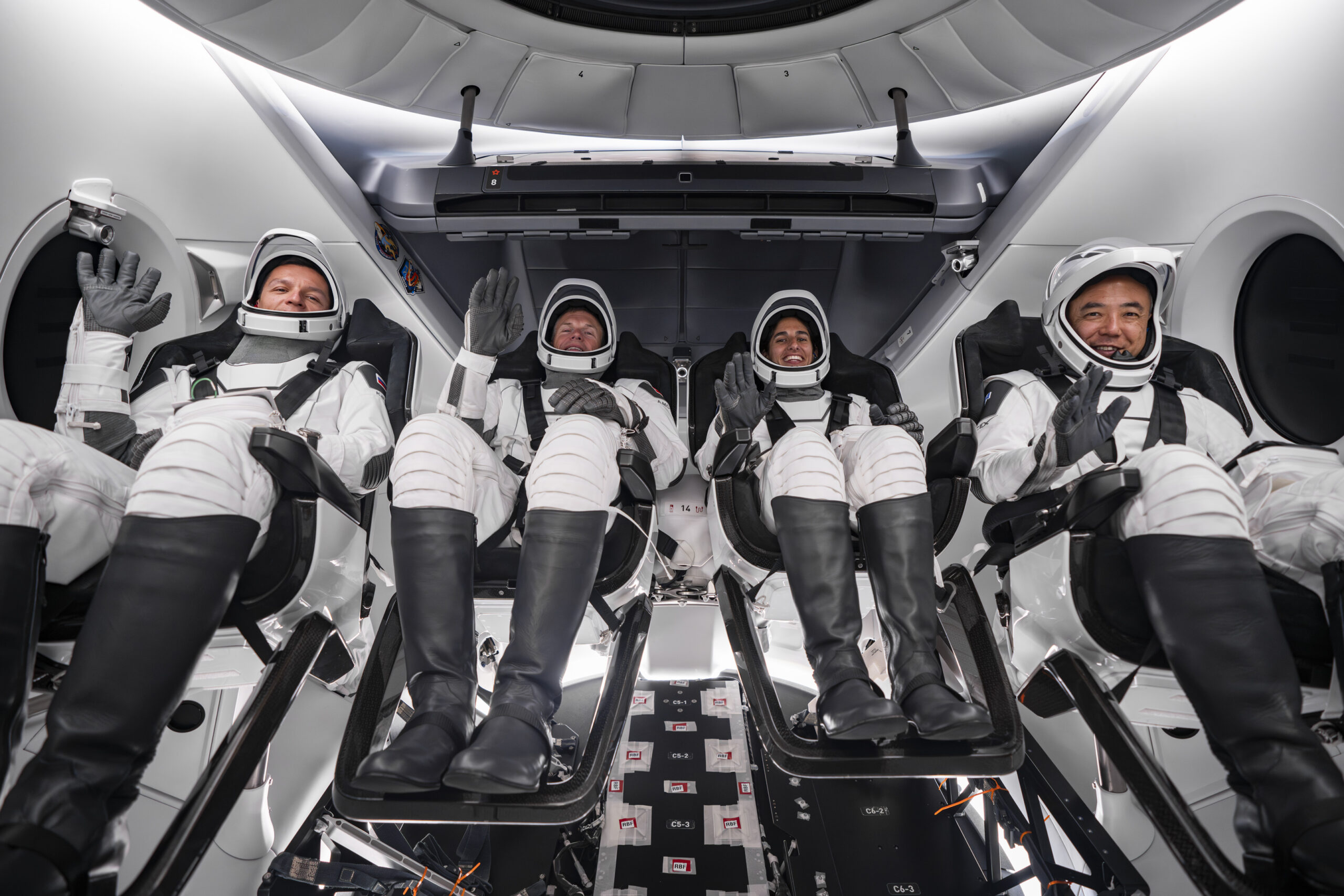
NASA, SpaceX, and international partners have completed the launch readiness review for the agency’s Crew-7 mission to the International Space Station. Crew-7 managers gathered at NASA’s Kennedy Space Center in Florida at 9 p.m. EDT Wednesday to review the SpaceX Falcon 9 rocket and Dragon spacecraft readiness and decided launch is “Go” for liftoff to the space station. Launch now is targeted for 3:50 a.m. EDT Friday, Aug. 25, from Kennedy’s Launch Complex 39A. If needed, a backup launch opportunity is available at 3:27 a.m. Saturday, Aug. 26.
On Wednesday, rocket and ground systems engineering teams completed the detailed data reviews following the integrated static fire of the Falcon 9 rocket conducted the day before at Launch Complex 39A. Falcon 9 performance was normal, resulting in a successful full duration static fire of all nine Merlin first-stage engines.
Operations teams are not tracking any major issues with Falcon 9 or the Dragon spacecraft. NASA and SpaceX spent Wednesday working toward final launch readiness, with remaining work expected to be completed ahead of launch.
The International Space Station Program is monitoring the potential need for a debris avoidance maneuver early afternoon Thursday, Aug. 24, for the orbital outpost. Space station mission control trajectory teams are tracking the debris and determining whether a short duration burn of the station’s thrusters would be required. If needed, the maneuver is not expected to impact the planned arrival of the Roscosmos ISS Progress cargo spacecraft also on Thursday. More information will be provided as orbital trajectory teams review the data and determine whether the debris would fly in the vicinity of the space station requiring a change in station’s altitude.
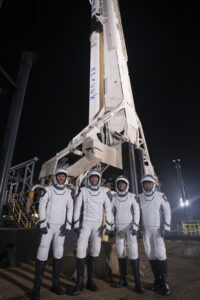
On Tuesday, Crew-7 NASA astronaut Jasmin Moghbeli, commander; ESA (European Space Agency) astronaut Andreas Mogensen, pilot; and mission specialists JAXA (Japan Aerospace Exploration Agency) astronaut Satoshi Furukawa, and Roscosmos cosmonaut Konstantin Borisov participated in a rehearsal of launch day activities in preparation for the upcoming Crew-7 launch.
Rehearsal began with launch teams assisting Crew-7 crewmates into their SpaceX spacesuits inside the Astronaut Crew Quarters at Kennedy’s Neil A. Armstrong Operations and Checkout Building – just as they will on launch day. Next, the crew took the elevator down to the ground floor and exited the building’s double doors, where Tesla Model X vehicles were waiting to drive them the short distance to the launch site.
After they arrived at the launch pad, Moghbeli, Mogensen, Furukawa, and Borisov rode the launch tower’s elevator up to the crew access arm – the walkway they will use to enter Dragon, named Endurance. Once securely seated inside, the crew members checked their communications systems and performed seat rotation and suit leak checks. The rehearsal concluded with closure of the spacecraft’s side hatch, which normally occurs about one hour and 25 minutes before liftoff.
Forecasters with Cape Canaveral Space Force Station’s 45th Weather Squadron predict a 90% chance of favorable weather conditions for launch, with the cumulus cloud rule serving as the primary weather concern.
Starting at 11:45 p.m. EDT Thursday, Aug. 24, the live broadcast of the mission – including liftoff and postlaunch milestones – will air on NASA Television and the agency’s website. Check the Crew-7 blog starting at 11 p.m., for key events leading up to launch and through spacecraft separation.
We’ll keep you updated on the key milestones throughout this mission. Details about the mission and NASA’s Commercial Crew Program can be found by following the Crew-7 blog, the commercial crew blog, @commercial_crew on X, and commercial crew on Facebook.
NASA’s SpaceX Crew-7 Astronauts Depart Houston for Florida
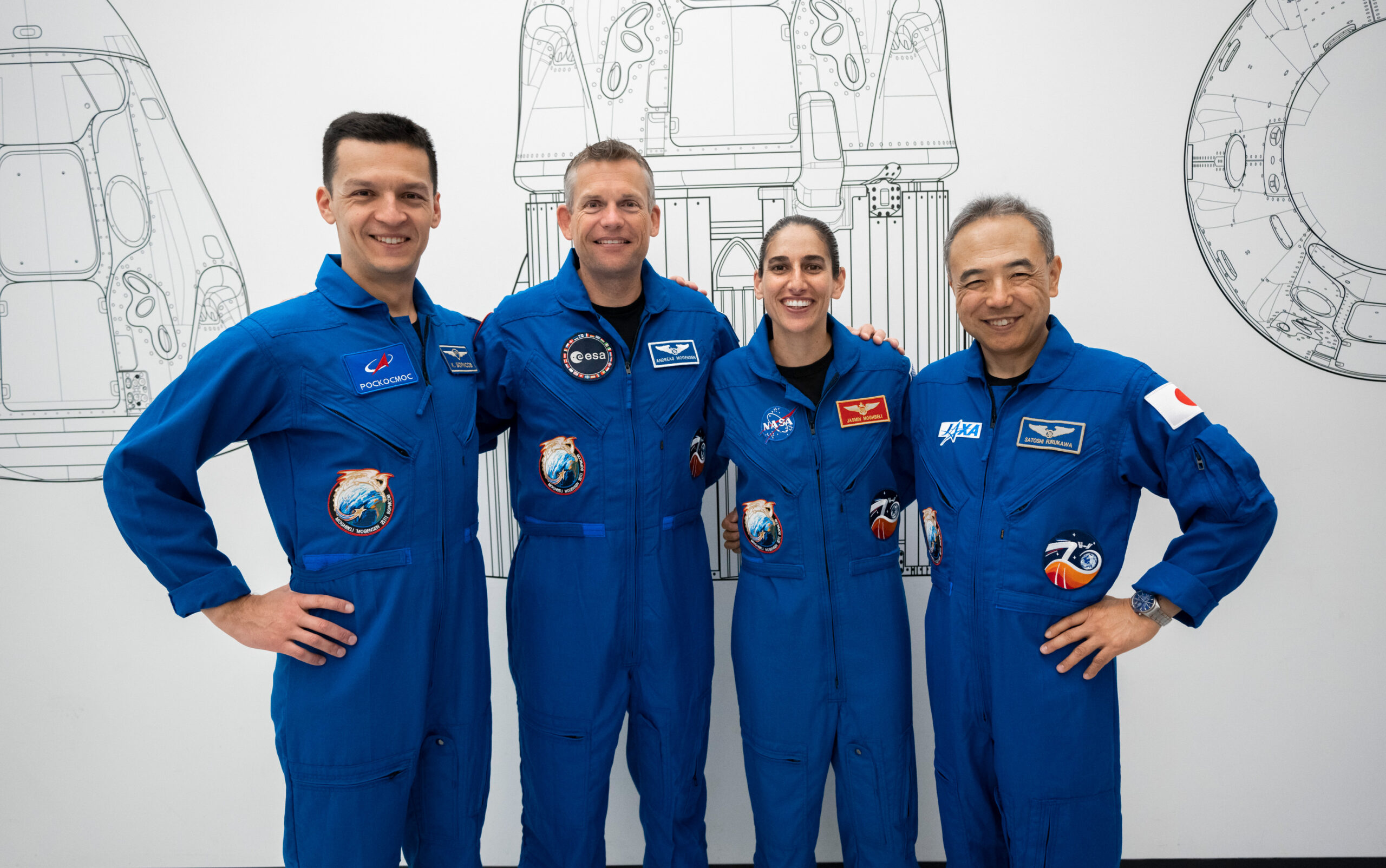
NASA’s SpaceX Crew-7 crew members now are en route to the agency’s Kennedy Space Center in Florida to begin final launch preparations.
Crew-7 crewmates NASA astronaut Jasmin Moghbeli, commander; ESA (European Space Agency) astronaut Andreas Mogensen, pilot; and mission specialists JAXA (Japan Aerospace Exploration Agency) astronaut Satoshi Furukawa, and Roscosmos cosmonaut Konstantin Borisov, departed by plane from Ellington Field near the agency’s Johnson Space Center in Houston, Texas, for the short flight to the Florida spaceport. The crew is expected to arrive at the Launch and Landing Facility at Kennedy this afternoon.
Crew-7 astronauts will be greeted on their arrival by leaders from NASA, JAXA, and ESA for a brief welcome ceremony targeted for approximately 12:15 p.m. EDT. The event is scheduled to broadcast live, if weather permits, on NASA Television and the agency’s website.
SpaceX Crew-7 is targeted to launch at 3:49 a.m. EDT on Friday, Aug. 25, to the International Space Station.
Crew-7 Starts Health Stabilization, Visits Dragon Ahead of Launch
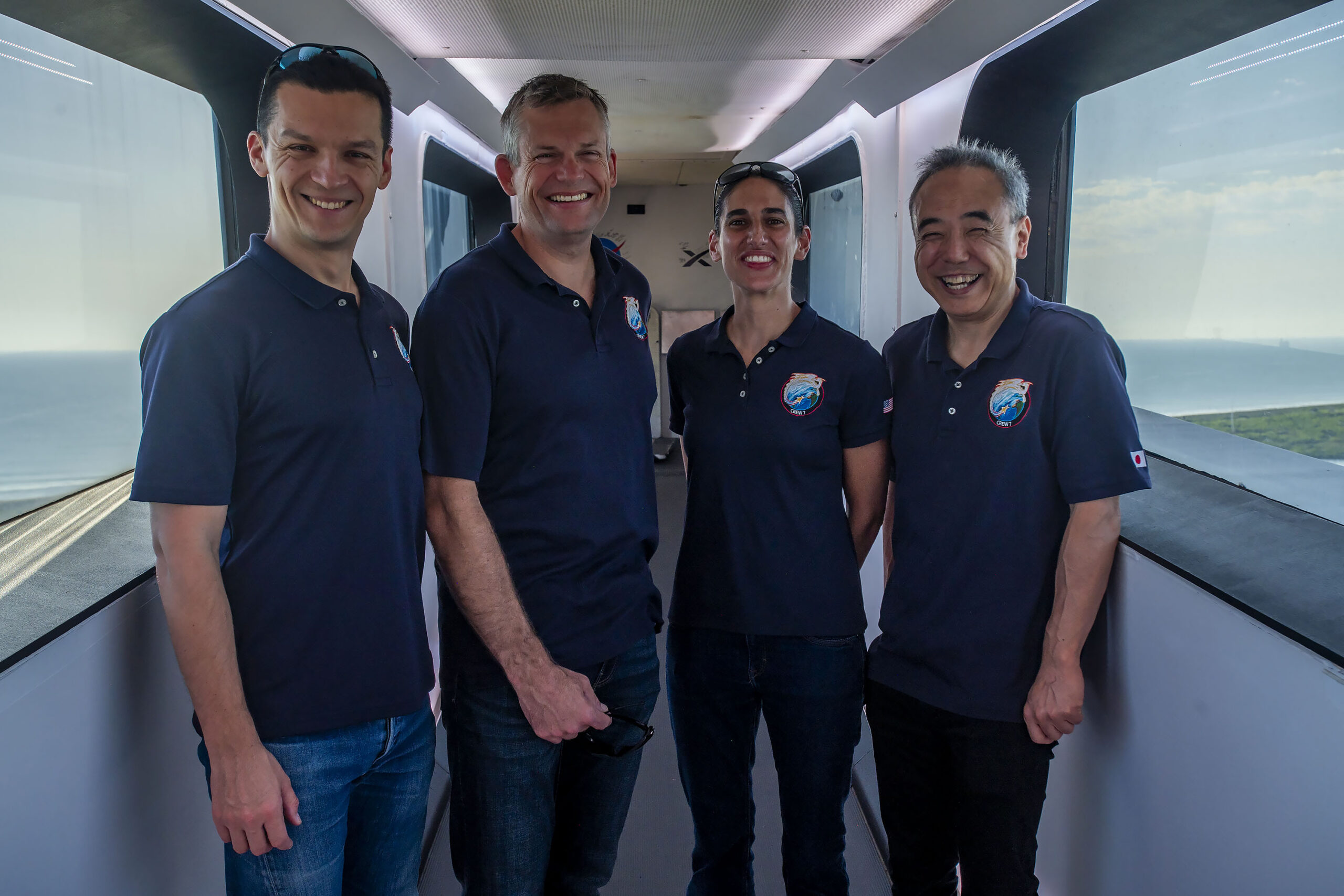
Crew members who will soon fly aboard NASA’s SpaceX Crew-7 mission will enter quarantine Friday in one of the major milestones before they head to the launch site in Florida to start their mission to the International Space Station.
The process of flight crew health stabilization is a routine part of final preparations for all missions to the space station. Spending the final two weeks before liftoff in quarantine will help ensure Crew-7 members are healthy, as well as protect the astronauts already on the space station. During the period, contact with other people are limited during the isolation time to avoid sickness. Family members and some launch and flight team members are cleared before they interact with the crew during this timeframe though most interactions are handled remotely.
Earlier this month, the crew visited the agency’s Kennedy Space Center in Florida for a close look at the spacecraft they will take them to the International Space Station.
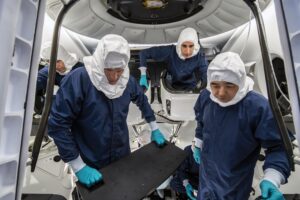
Gathered at SpaceX’s refurbishment facility at Cape Canaveral Space Force Station, the four crew members put on their flight suits, entered the spacecraft, performed leak checks and completed communications checkouts.
NASA astronaut Jasmin Moghbeli, commander; ESA (European Space Agency) astronaut Andreas Mogensen, pilot; and mission specialists JAXA (Japan Aerospace Exploration Agency) astronaut Satoshi Furukawa, and Roscosmos cosmonaut Konstantin Borisov will fly to the space station aboard SpaceX’s Dragon spacecraft, named Endurance, which previously supported the Crew-3 and Crew-5 missions to and from the orbiting laboratory.
The company’s Falcon 9 rocket is targeted to launch Crew-7 no earlier than 3:49 a.m. EDT on Friday, Aug. 25 from Launch Complex 39A at Kennedy. As part of the agency’s Commercial Crew Program, Crew-7 marks the eighth human spaceflight mission supported by a SpaceX Dragon spacecraft and the seventh crew rotation mission to the space station since 2020 for NASA.
The crew also listened to the Dragon spacecraft’s fans and pumps while inside the spacecraft to prepare themselves for the sounds they can expect to hear throughout the flight. They also took additional time to familiarize themselves with the interior of Dragon before leaving the spacecraft.
At SpaceX’s Launch Complex 39A, the crew took a familiarization tour of the launch site, completed emergency training, and rode the elevator to the top of the launch pad’s tower to enjoy a beautiful early morning view of Kennedy.
Follow the commercial crew blog for the latest information on Crew-7 progress and flight readiness as reviews and milestones continue. Details about the mission and NASA’s Commercial Crew Program can be found by following the Crew-7 blog, the commercial crew blog, @commercial_crew on X, and commercial crew on Facebook.
NASA, SpaceX Reset Crew-7 Launch to Friday, Aug. 25
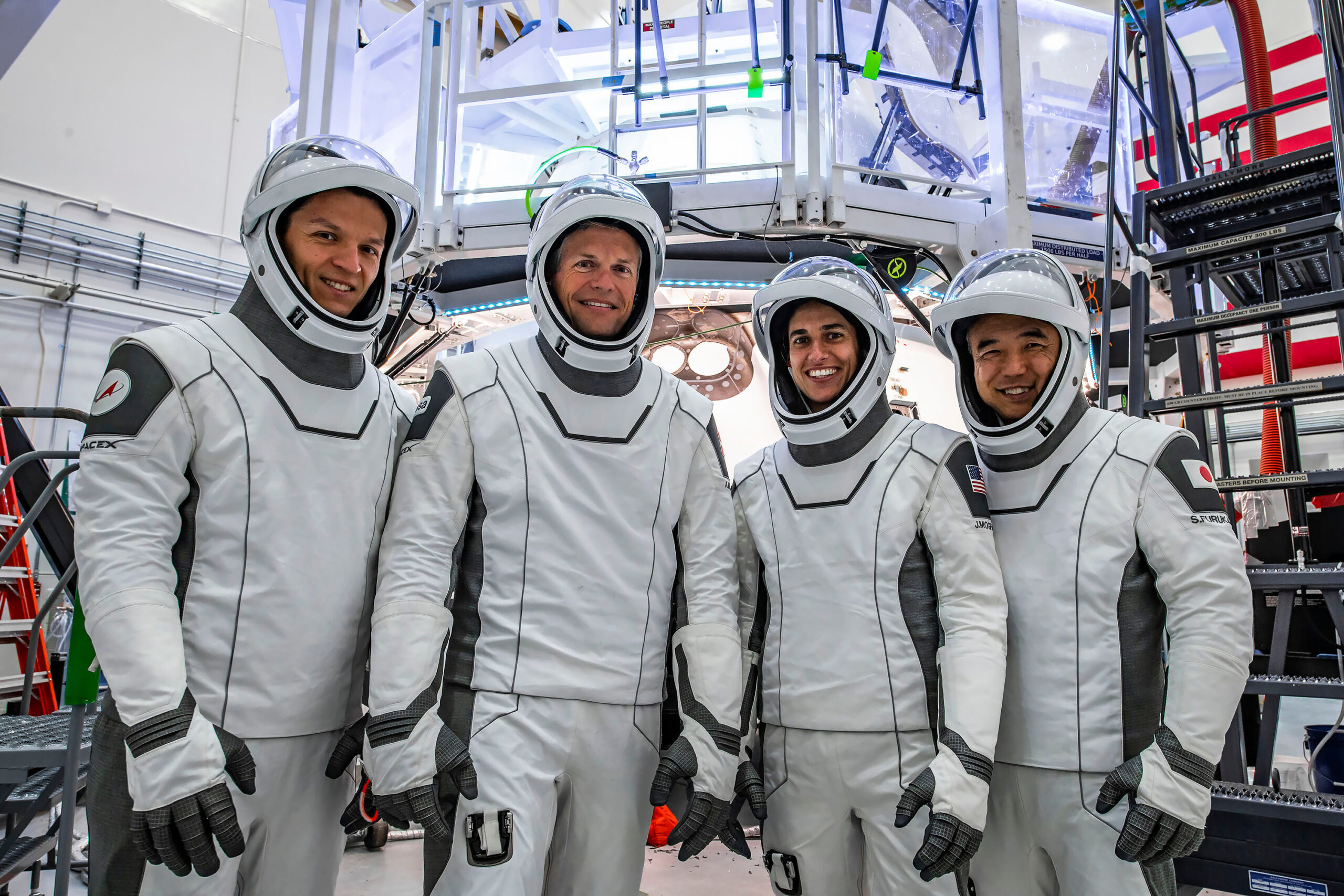
The target launch date for NASA’s SpaceX Crew-7 mission to the International Space Station now is 3:49 a.m. EDT Friday, Aug. 25. Additional time was required for teams to complete pad readiness after SpaceX’s recent Falcon Heavy mission lifted off from Launch Complex 39A at NASA’s Kennedy Space Center in Florida. The adjustment also takes advantage of consecutive launch opportunities and deconflicts the station’s cargo spacecraft traffic schedule.
NASA astronaut Jasmin Moghbeli, ESA (European Space Agency) astronaut Andreas Mogensen, JAXA (Japan Aerospace Exploration Agency) astronaut Satoshi Furukawa, and Roscosmos cosmonaut Konstantin Borisov will launch on a SpaceX Falcon 9 rocket aboard the company’s Dragon spacecraft.
Crew-7 is scheduled to dock to the orbiting laboratory about 2:45 a.m. Saturday, Aug. 26, to the space-facing port of the station’s Harmony module. If needed, Crew-7 has additional launch opportunities on Saturday, Aug. 26 and Sunday, Aug. 27.
Follow NASA’s commercial crew blog for the latest information on Crew-7 flight readiness.
Details about the mission and NASA’s Commercial Crew Program can be found by following the commercial crew blog, @commercial_crew on Twitter, and commercial crew on Facebook.
New Target Launch Date Set for Next Crewed Mission to Space Station
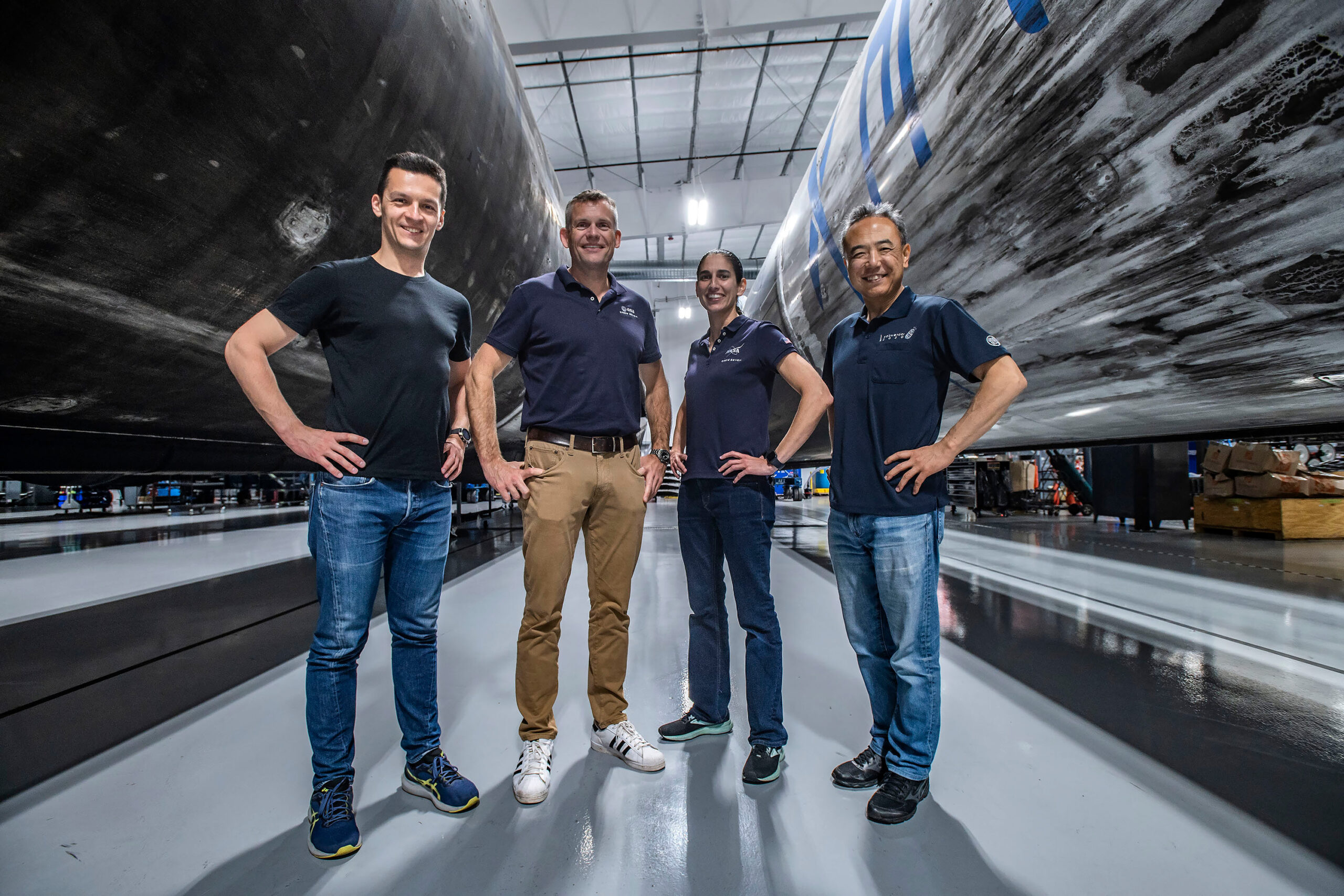
NASA and SpaceX now are targeting 5:23 a.m. EDT Monday, Aug. 21, for the launch of the agency’s Crew-7 mission to the International Space Station. The adjusted date allows additional time for launch site processing at Launch Complex 39A at NASA’s Kennedy Space Center in Florida. If needed, a backup opportunity is available at 3:49 a.m. on Friday, Aug. 25.
The target date is in coordination with activities aboard the International Space Station, including operations with other crew and cargo spacecraft. A Cygnus cargo spacecraft from Northrop Grumman and Roscosmos Progress cargo spacecraft are due at the station in the coming weeks.
NASA astronaut Jasmin Moghbeli, ESA (European Space Agency) astronaut Andreas Mogensen, JAXA (Japan Aerospace Exploration Agency) astronaut Satoshi Furukawa, and Roscosmos cosmonaut Konstantin Borisov will fly aboard the SpaceX Dragon spacecraft, named Endurance, which previously flew NASA’s SpaceX Crew-3 and Crew-5 missions to the space station. This will be the first launch of the Falcon 9 booster SpaceX selected to support this mission.
All hardware for the mission has arrived in Florida for processing. On July 25, the Dragon spacecraft was stacked to its trunk ahead of its upcoming transport to SpaceX’s hangar at Launch Complex 39A. Once preflight checkouts of the spacecraft are complete, Dragon will be mated to the rocket ahead of the integrated system’s rollout to the launch pad.
Follow NASA’s commercial crew blog for the latest information on Crew-7 flight readiness.
Details about the mission and NASA’s Commercial Crew Program can be found by following the commercial crew blog, @commercial_crew on Twitter, and commercial crew on Facebook.
NASA, SpaceX Adjust Crew-7 Launch Date

NASA and its commercial and international partners now are targeting launch at 6:56 a.m. Thursday, Aug. 17, for the agency’s SpaceX Crew-7 mission to the International Space Station. The new date – a shift of two days – allows for launch pad reconfiguration following a SpaceX Falcon Heavy mission from Launch Complex 39A at the agency’s Kennedy Space Center in Florida.
The announcement came during a briefing held July 25 by NASA representatives along with officials from ESA (European Space Agency), JAXA (Japan Aerospace Exploration Agency), and SpaceX. Each agency – NASA, ESA, and JAXA – along with Roscosmos has a crew member among the four who make up the Crew-7 mission. Discussing a range of topics related to readiness for the mission, the officials highlighted the training the crew of four has moved through along with details of the six-month mission and the research that will be performed in orbit across several scientific disciplines.
Mission teams also provided several other updates on upcoming space station missions.
A replay of the mission overview news conference is available on the agency’s YouTube channel.
Following the briefing, NASA astronaut Jasmin Moghbeli, ESA astronaut Andreas Mogensen, JAXA astronaut Satoshi Furukawa, and Roscosmos cosmonaut Konstantin Borisov of Crew-7, as well as NASA astronaut Loral O’Hara talked to media about training for their upcoming missions to the space station. O’Hara will launch in September from the Baikonur Cosmodrome in Kazakhstan.
A replay of the crew news conference is available on the agency’s YouTube channel.
Crew-7 is the seventh rotational mission to the International Space Station for NASA’s Commercial Crew Program. Launching atop a Falcon 9 rocket from Kennedy’s Launch Complex 39A, SpaceX’s Dragon spacecraft will carry Jasmin Moghbeli, Andreas Mogensen, Satoshi Furukawa, and Konstantin Borisov to the orbiting laboratory.
More details about the mission and NASA’s Commercial Crew Program can be found by following the commercial crew blog, @commercial_crew on Twitter, and commercial crew on Facebook.
NASA, SpaceX Provide Crew-7 Hardware Operations Status
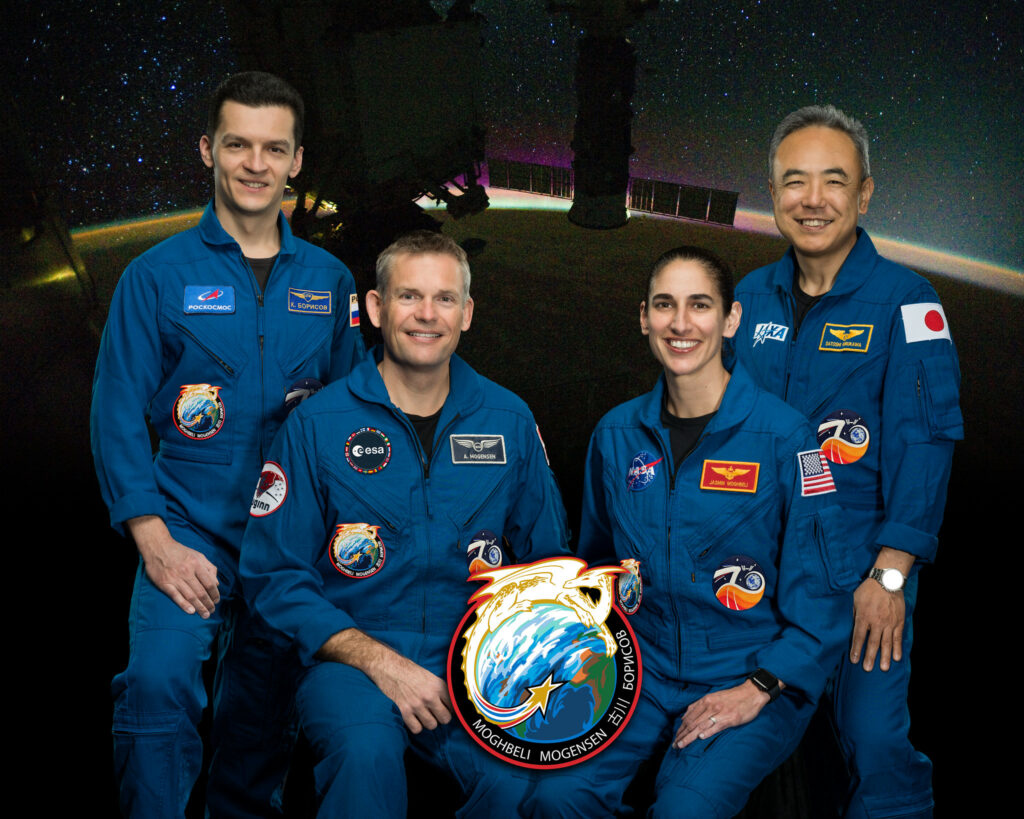
NASA and SpaceX are preparing for the seventh rotational mission of the company’s human space transportation system to the International Space Station as part of the agency’s Commercial Crew Program. The earliest targeted launch date for NASA’s SpaceX Crew-7 mission is Tuesday, Aug. 15, from NASA’s Kennedy Space Center in Florida.
NASA astronaut Jasmin Moghbeli, ESA (European Space Agency) astronaut Andreas Mogensen, JAXA (Japan Aerospace Exploration Agency) astronaut Satoshi Furukawa, and Roscosmos cosmonaut Konstantin Borisov will fly aboard the SpaceX Dragon spacecraft, named Endurance, which previously flew on NASA’s SpaceX Crew-3 and Crew-5 missions. This will be the first launch for the Falcon 9 rocket booster SpaceX selected to support this mission.
Dragon currently is being prepared for flight at SpaceX’s processing facility in Cape Canaveral, Florida. As part of the refurbishment process, teams will install new components, including the heat shield, parachutes, and Draco engines in addition to a flight-proven nosecone. SpaceX recently completed Dragon’s propulsion system checkouts and will soon mate the heat shield to the spacecraft. Once refurbishment is complete, Dragon will be stacked to its trunk ahead of transportation to SpaceX’s hangar at nearby Launch Complex 39A at Kennedy.
Following static fire testing at a SpaceX facility in Texas, the booster will undergo stage testing and further assessments prior to acceptance and certification for flight.
Once all rocket and spacecraft system checkouts are complete and components are certified for flight, SpaceX teams will mate Dragon to the Falcon 9 rocket in the company’s hangar at Launch Complex 39A. Teams will then roll the integrated spacecraft and rocket to the pad and raise it to a vertical position for an integrated static fire test prior to launch.
Following liftoff, the Falcon 9 first stage will separate from the second stage and land at SpaceX’s Landing Zone 1 at Cape Canaveral Space Force Station. Upon its arrival to the space station, Crew-7 will dock to the space-facing, or zenith, port of the Harmony module.
Follow NASA’s commercial crew blog for the latest information on Crew-7 progress and flight readiness as reviews and milestones continue. NASA and its partners will host a media event in the coming weeks to discuss more about Crew-7 progress.
Details about the mission and NASA’s commercial crew program can be found by following the commercial crew blog, @commercial_crew on Twitter, and commercial crew on Facebook.
Mission Specialist Assigned to NASA’s SpaceX Crew-7 Mission
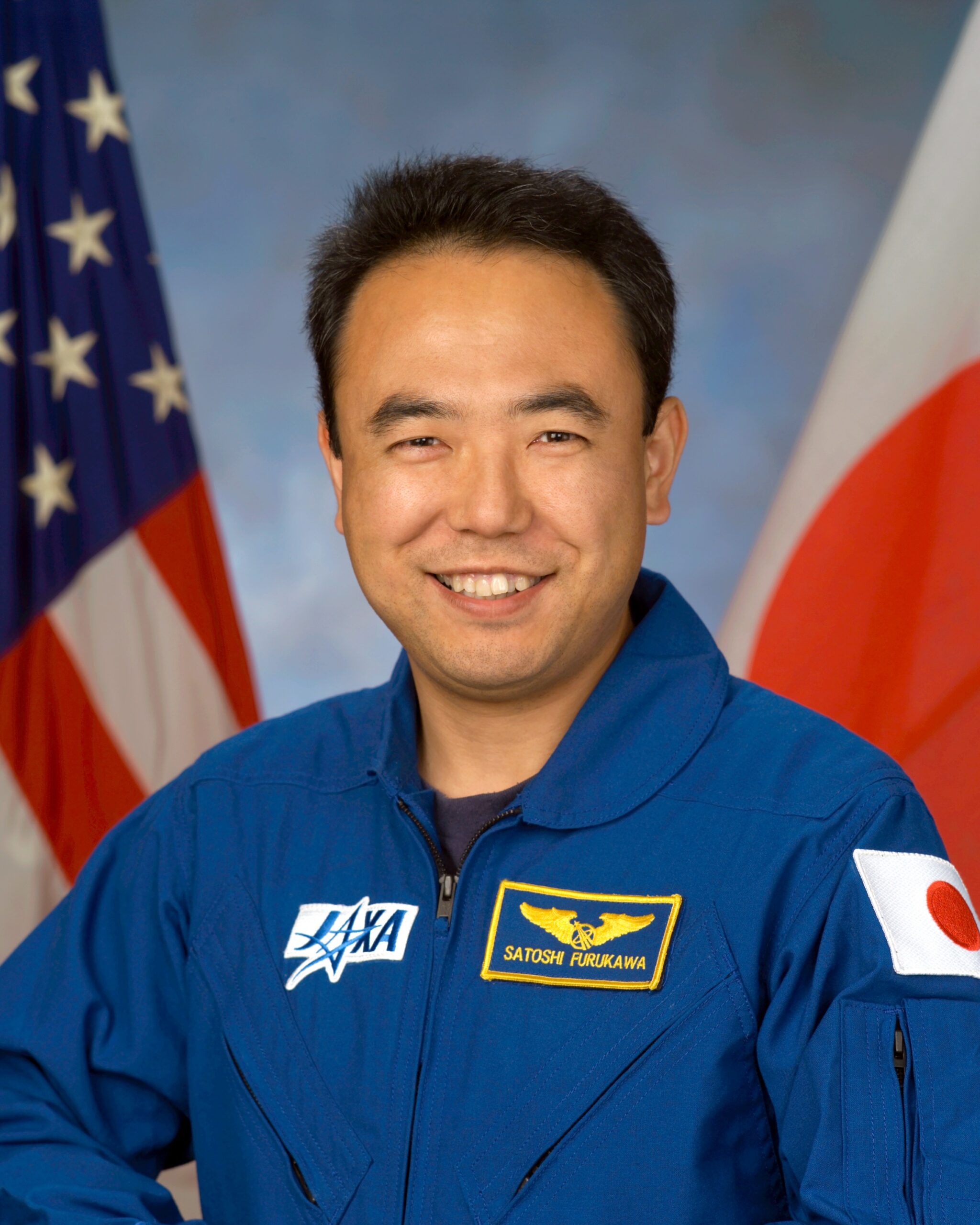
Astronaut Satoshi Furukawa from JAXA (Japan Aerospace Exploration Agency) has been selected as a mission specialist for NASA’s SpaceX Crew-7 mission – the agency’s seventh rotational mission to the International Space Station.
Furukawa joins NASA astronaut Jasmin Moghbeli and ESA (European Space Agency) astronaut Andreas Mogensen, who will serve as spacecraft commander and pilot, respectively. An additional crew member will be assigned at a later date.
Furukawa spent 165 days aboard the orbiting laboratory in 2011 as a flight engineer with Expeditions 28 and 29. As part of his duties, he helped support the final space shuttle mission, STS-135.
This will be the first spaceflight for Moghbeli, who became a NASA astronaut in 2017, and the first long-duration mission for Mogensen. He previously served as a flight engineer on a 10-day mission to the space station in 2015. Crew-7 will be his second trip to space.
NASA and SpaceX are targeting no earlier than mid-August for the launch of Crew-7, aboard a SpaceX Dragon spacecraft and Falcon 9 rocket from Launch Complex 39A at NASA’s Kennedy Space Center in Florida. The four astronauts will join an expedition crew aboard the space station.
For more insight on NASA’s Commercial Crew Program missions to the orbiting laboratory, follow the commercial crew blog. More details can be found @commercial_crew on Twitter and commercial crew on Facebook.
NASA, SpaceX Target Mid-August for Crew-7 Launch
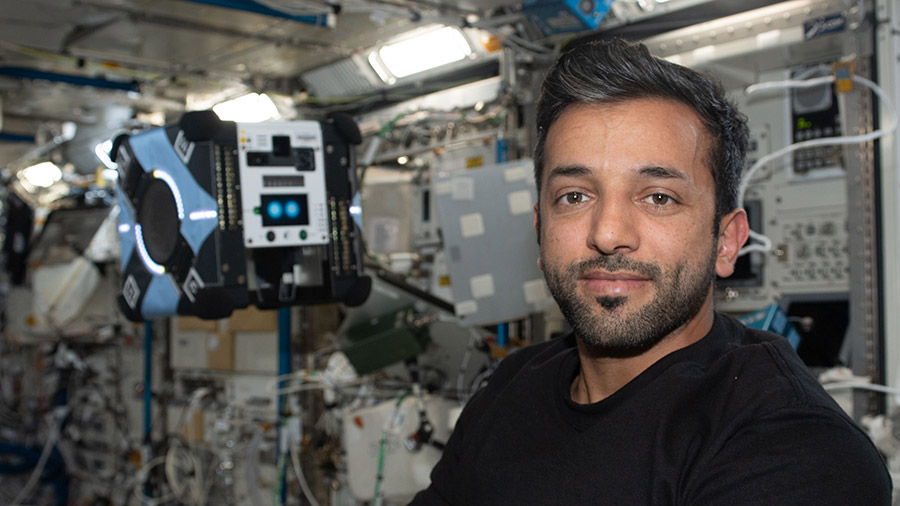
NASA and SpaceX are targeting mid-August for the launch of Crew-7, the next rotational mission to the International Space Station aboard a SpaceX Dragon spacecraft and Falcon 9 rocket from Launch Complex 39A at NASA’s Kennedy Space Center in Florida.
NASA astronaut Jasmin Moghbeli and ESA (European Space Agency) astronaut Andreas Mogensen will serve as spacecraft commander and pilot, respectively, for the mission. Two mission specialists will be announced later, following review by NASA and its international partners. Moghbeli, Mogensen, and the additional mission specialists will join an expedition crew aboard the space station.
Crew Flight Test Targeting July 21
Launch of NASA’s Boeing Crew Flight Test (CFT) to the International Space Station is targeted for no earlier than Friday, July 21, pending coordination for the U.S. Eastern Range availability. The new target date provides NASA and Boeing the necessary time to complete subsystem verification testing and close out test flight certification products and aligns with the space station manifest and range launch opportunities.
Space Station Cargo, Research Work Ongoing
The Expedition 69 crew members continue unpacking the SpaceX Dragon resupply ship in the midst of human research and pharmaceutical studies aboard the International Space Station. NASA and its commercial crew partners have also announced upcoming missions to the station.
Flight Engineers Frank Rubio of NASA and Sultan Alneyadi of UAE (United Arab Emirates) took turns working inside the SpaceX Dragon cargo craft on Thursday. The duo has been offloading some of the 6,200 pounds new research gear and crew supplies packed inside the Cargo Dragon. The U.S. commercial space freighter will remain docked to the Harmony module’s forward port until mid-April when it will return to Earth filled with completed science experiments and other cargo for retrieval and analysis.
Rubio started his day pedaling on the station’s exercise bike while attached to sensors to measure his aerobic capacity in microgravity. Afterward, he performed research work in the Columbus laboratory module to understand how the different gravity levels of the Moon, Mars, and beyond may affect the biomanufacturing of pharmaceuticals.
Alneyadi’s first task of the day was to install an incubator in the Kibo laboratory module and later activate it in the afternoon. He also collected surface samples throughout the space station for microbial analysis back on Earth.
Station Commander Sergey Prokopyev was joined by Rubio and Roscosmos Flight Engineer Dmitri Petelin during the morning checking their Soyuz launch and entry suits for leaks. Prokopyev and Petelin then tested communications with the ISS Progress 83 cargo craft docked to the Zvezda service module’s rear port. Flight Engineer Andrey Fedyaev worked throughout Thursday on computer maintenance and orbital plumbing tasks.
